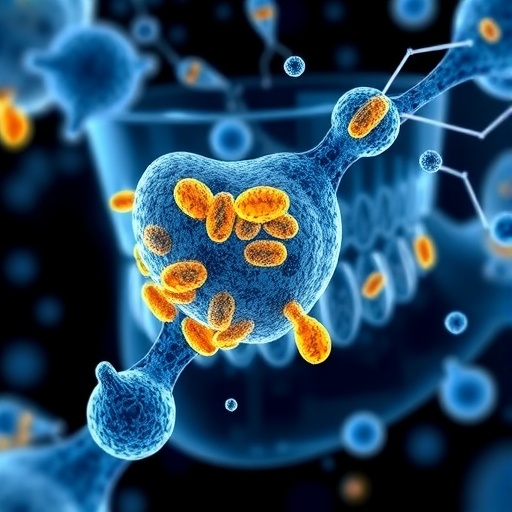In a groundbreaking advancement poised to reshape our understanding of neurodegenerative diseases, a team of researchers led by Wang, Milton, and Fearnley has illuminated the complex genetic landscape underlying Parkinson’s disease (PD) and Lewy Body Dementia (LBD). This new study, recently published in npj Parkinson’s Disease, decisively identifies expanded and interrupted repeat expansions in the ATXN2 gene among cohorts afflicted with these debilitating conditions. The implications of their work reach far beyond mere genetic annotation; they unveil crucial mechanistic insights that may catalyze the development of novel therapeutic strategies.
Parkinson’s disease and Lewy Body Dementia represent a formidable clinical challenge, characterized by progressive motor dysfunction and cognitive decline, respectively. Although the pathological hallmarks—such as alpha-synuclein aggregation and widespread neuronal loss—are well documented, the molecular triggers remain somewhat elusive. The study’s focus on ATXN2 repeat expansions introduces a fresh genetic paradigm, suggesting that subtle variations within this gene can profoundly influence disease susceptibility and phenotype.
Historically, ATXN2 has been predominantly linked to spinocerebellar ataxia type 2 (SCA2), a disorder caused by trinucleotide repeat expansions leading to neurodegeneration. However, the novel detection of expanded yet interrupted repeats in PD and LBD patients signals an unexpected intersection of pathogenic pathways. The interruptions within the expanded sequences may modulate the toxicity typically associated with pure repeat expansions, hinting at a nuanced form of genetic instability that could affect protein function and neuronal resilience.
To elucidate these findings, the researchers conducted comprehensive genetic screenings across multiple cohorts. Using advanced sequencing technologies, they identified not only the presence of expanded ATXN2 alleles but also complex interruption patterns previously undetected by standard assays. These interrupted expansions appear to escape some of the regulatory mechanisms that usually mitigate repeat-induced cytotoxicity, potentially leading to aberrant ATXN2 protein aggregation and deleterious interactions with RNA-binding proteins.
Intriguingly, the pathogenic potential of these interrupted expansions lies in their capacity to disrupt normal RNA metabolism—a process vital for neuronal health. ATXN2 is known to participate in RNA processing and stress granule formation, both of which are critical for managing cellular stress. Altered repeat expansions may perturb these functions, precipitating deficits in RNA stability and translation that culminate in neuronal dysfunction. This mechanistic insight bridges the gap between genetic mutation and cellular pathology in PD and LBD.
Moreover, the study delineates a correlation between the size and complexity of these expansions with the severity of clinical manifestations. Patients harboring larger or more intricate interruptions exhibited more rapid disease progression and pronounced cognitive decline. This genotype-phenotype relationship underscores the potential utility of ATXN2 repeat profiling not only as a diagnostic biomarker but also as a prognostic tool, guiding personalized therapeutic approaches.
From a therapeutic standpoint, these discoveries open avenues for targeting the pathological consequences of repeat expansions at multiple levels. Approaches could include gene silencing technologies such as antisense oligonucleotides, designed to reduce mutant transcript levels, or small molecules capable of stabilizing RNA-protein interactions disrupted by the ATXN2 mutations. Furthermore, the modulation of stress granule dynamics emerges as a promising strategy to rescue neuronal function compromised by these genetic aberrations.
This paradigm shift in understanding the genetic complexity of PD and LBD emphasizes the necessity of considering interrupted repeats as distinct entities with unique pathogenic properties. Unlike pure expansions that induce toxicity primarily through protein aggregation, interrupted repeats may also instigate RNA toxicity and impaired cellular stress responses. This dual mechanism elevates ATXN2 as a pivotal genetic contributor warranting detailed investigation in neurodegenerative research.
The work also provokes reconsideration of existing genetic testing frameworks. Traditional assays, often calibrated to detect pure trinucleotide expansions, may overlook pathogenic interrupted repeats. Consequently, refining diagnostic methodologies to capture this heterogeneity will be essential for accurate patient stratification and for unlocking the full spectrum of ATXN2-associated pathologies.
By integrating these genetic insights with neuropathological data, the research community gains a more holistic understanding of the molecular events driving PD and LBD. The intersection between retrotransposon-driven genomic instability and RNA processing dysfunction highlighted by ATXN2 abnormalities provides a fertile ground for identifying convergent pathways that unify disparate neurodegenerative conditions.
Additionally, the identification of interrupted ATXN2 expansions compels a reevaluation of genetic risk assessment in family members of affected individuals. The inheritance patterns and penetrance of such interrupted expansions remain to be fully delineated, but preliminary evidence suggests a complex interplay between environmental factors and genetic susceptibility that modulates clinical outcome.
Looking ahead, longitudinal studies tracking the evolution of ATXN2 repeat length and interruption patterns over time will be instrumental. Such studies could reveal dynamic processes of repeat instability that contribute to disease onset and progression, offering critical windows for therapeutic intervention before significant neurodegeneration ensues.
The implications of this research extend beyond molecular biology into clinical practice and public health. Identifying genetic contributors to PD and LBD with such precision facilitates early diagnosis, informs prognosis, and potentially enables pre-symptomatic screening in at-risk populations. This transforms the landscape of neurodegenerative disease management from reactive to proactive.
In sum, the pioneering work by Wang and colleagues heralds a new era in the genetics of neurodegeneration. By peeling back layers of complexity within ATXN2 repeat expansions, they uncover pathogenic nuances that reshape our comprehension of Parkinson’s disease and Lewy Body Dementia. Their findings pave the way for innovative diagnostics and therapeutic paradigms, energizing efforts to quell the growing burden of these devastating disorders.
As research continues to unravel the intricate genetic architecture of neurodegeneration, the role of interrupted repeat expansions likely represents just the tip of the iceberg. The convergence of high-resolution genomic technologies with deep phenotypic profiling promises a future where neurodegenerative diseases are not only better understood but also more effectively treated and, ultimately, prevented.
Subject of Research: Genetic underpinnings and mechanisms of Parkinson’s disease and Lewy Body Dementia focusing on ATXN2 repeat expansions.
Article Title: Identification of expanded and interrupted ATXN2 repeat expansions in Parkinson’s disease and Lewy Body Dementia cohorts.
Article References:
Wang, L., Milton, M., Fearnley, L.G. et al. Identification of expanded and interrupted ATXN2 repeat expansions in Parkinson’s disease and Lewy Body Dementia cohorts. npj Parkinsons Dis. 11, 341 (2025). https://doi.org/10.1038/s41531-025-01188-5
Image Credits: AI Generated
DOI: https://doi.org/10.1038/s41531-025-01188-5
Tags: alpha-synuclein aggregationATXN2 gene mutationscognitive decline in Lewy Body Dementiaexpanded repeat expansionsgenetic landscape of neurodegenerationLewy Body Dementia mechanismsmotor dysfunction in Parkinson’sneurodegeneration genetic factorsneurodegenerative disease therapiesnovel therapeutic strategies for PDParkinson’s disease genetic researchspinocerebellar ataxia type 2





